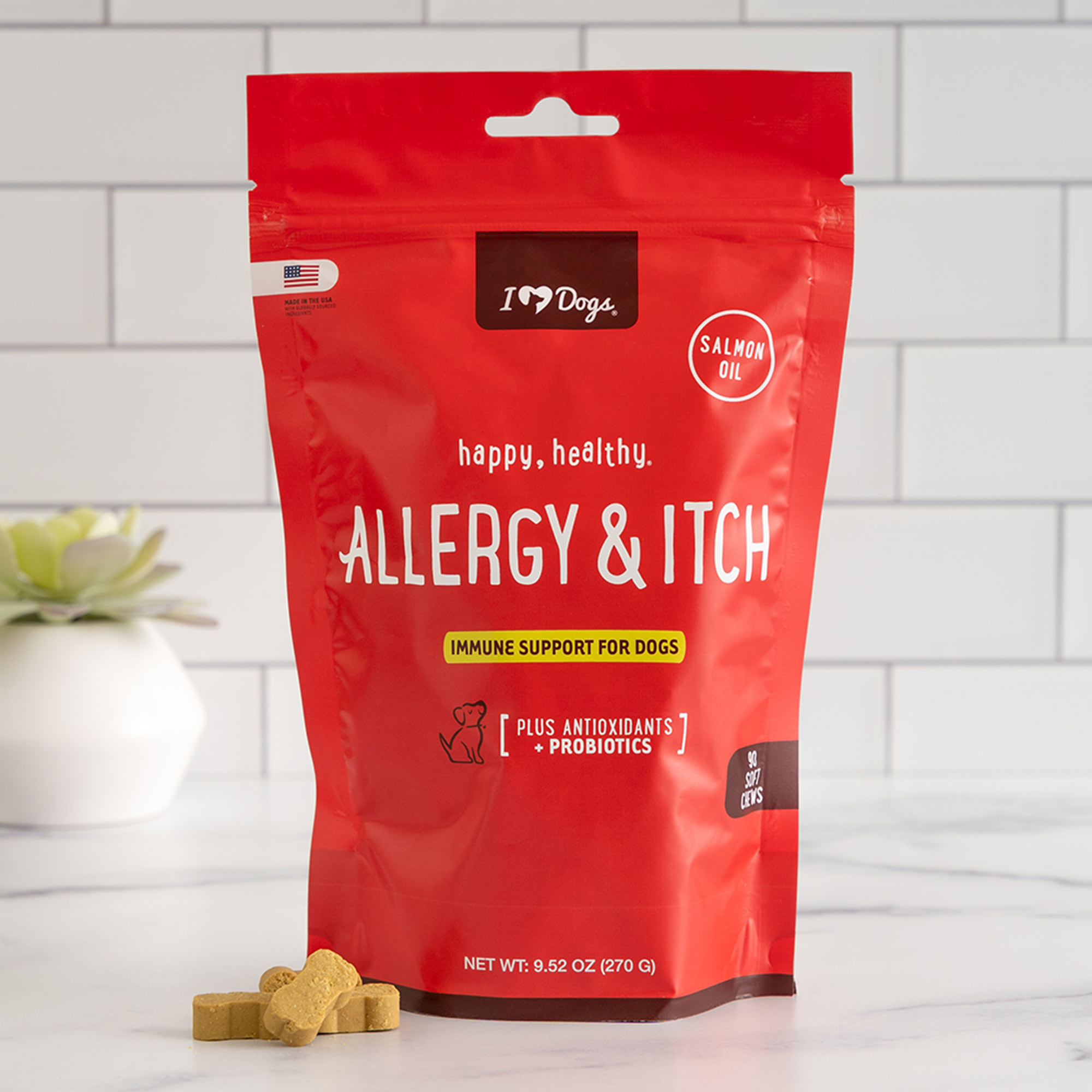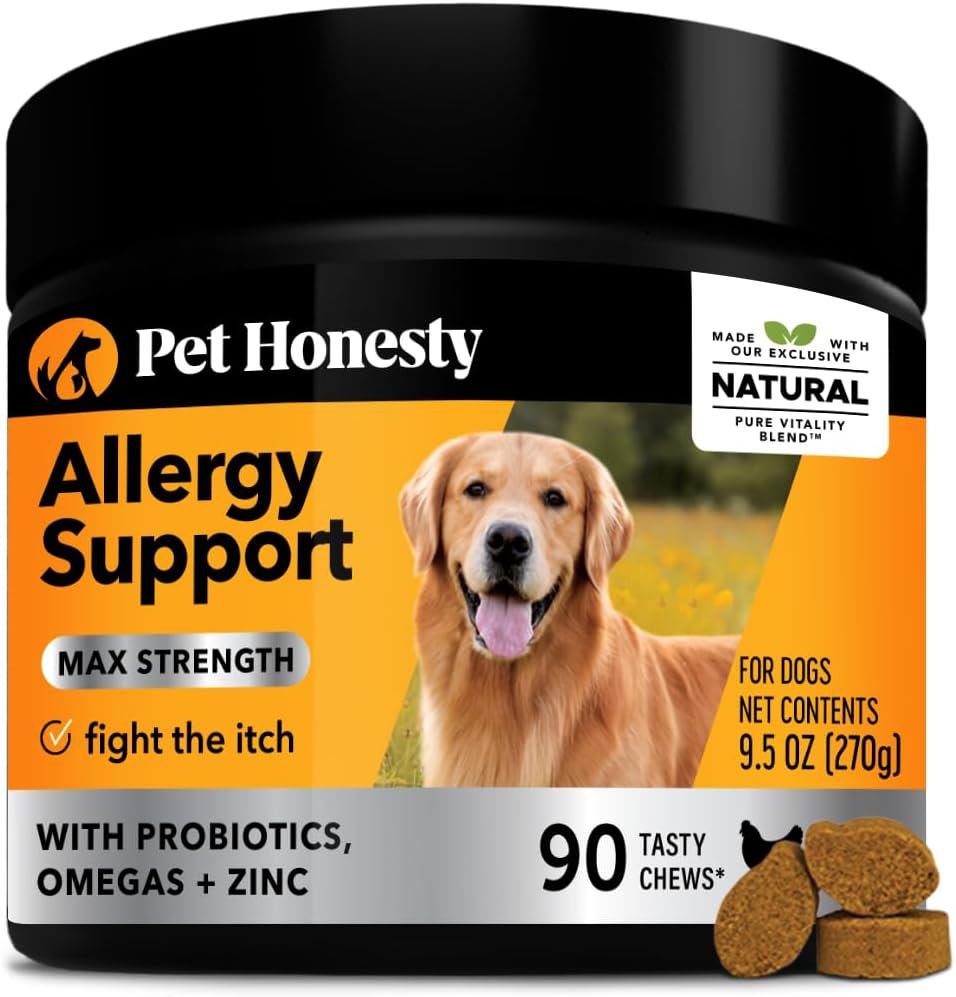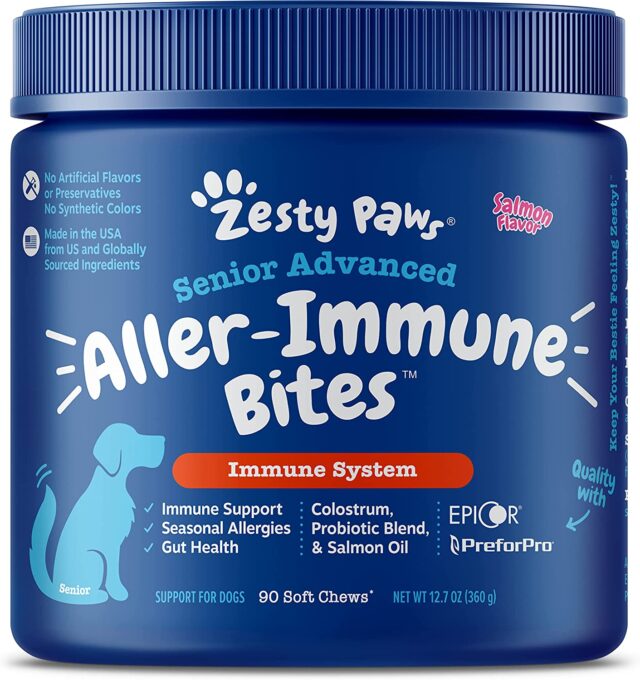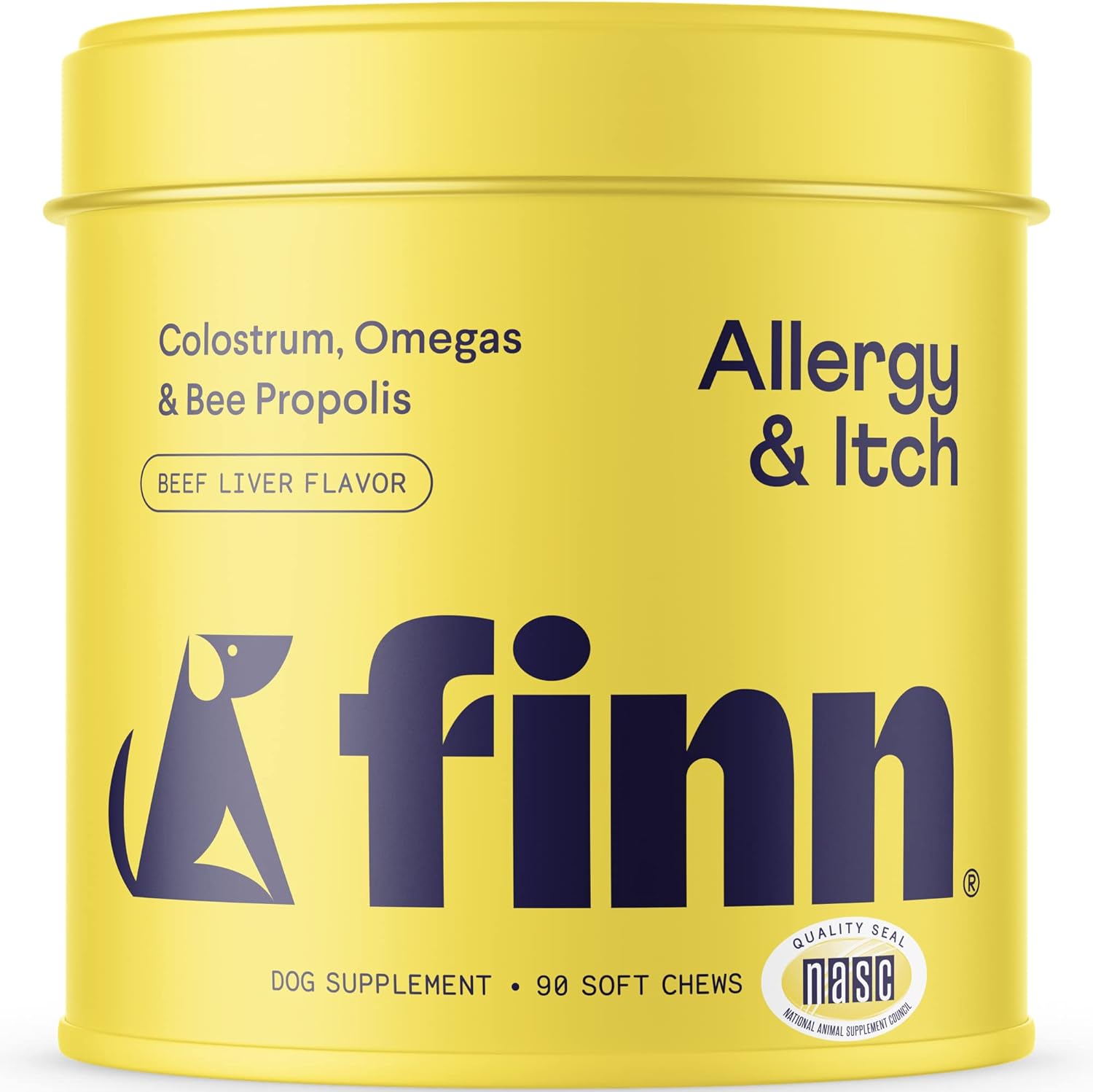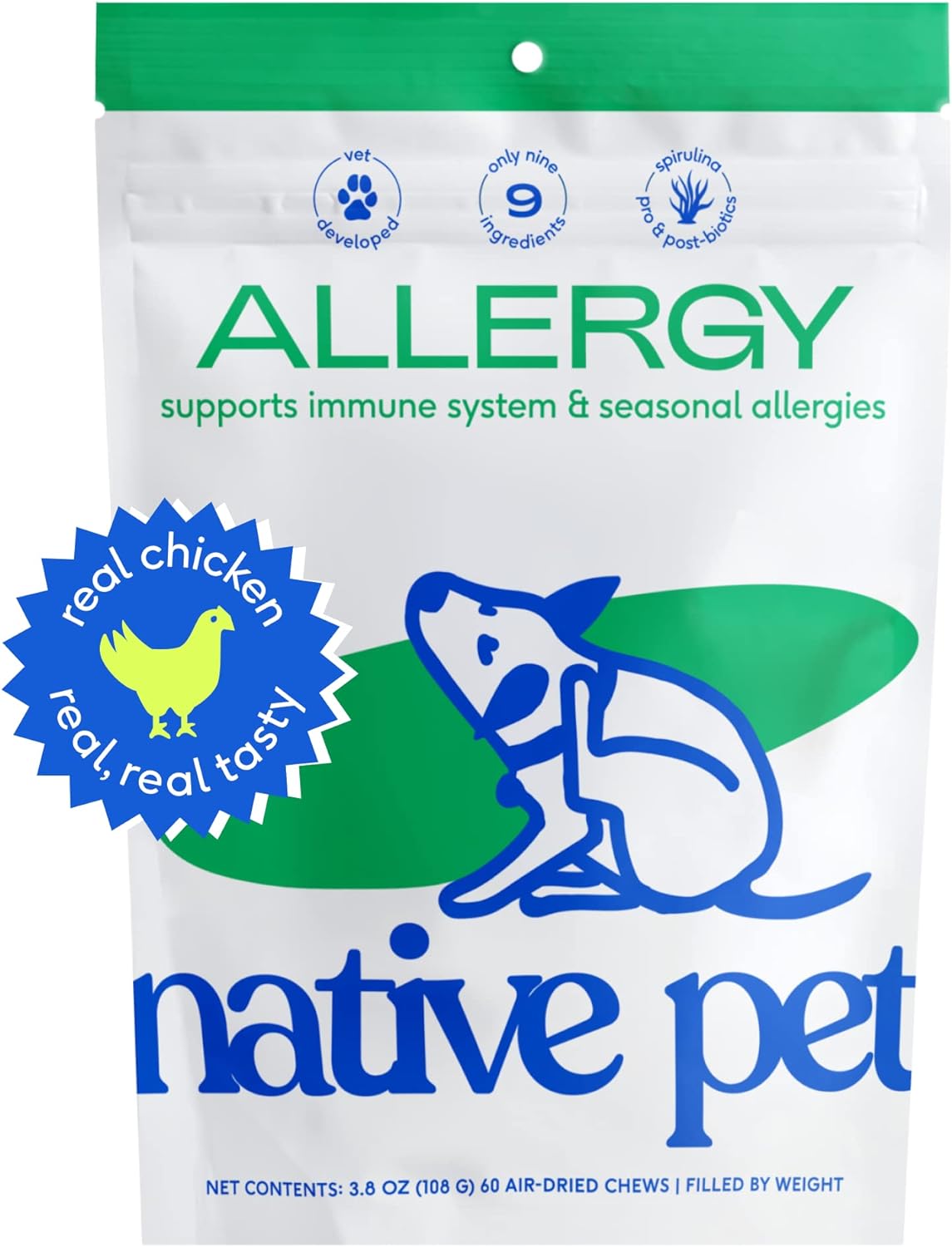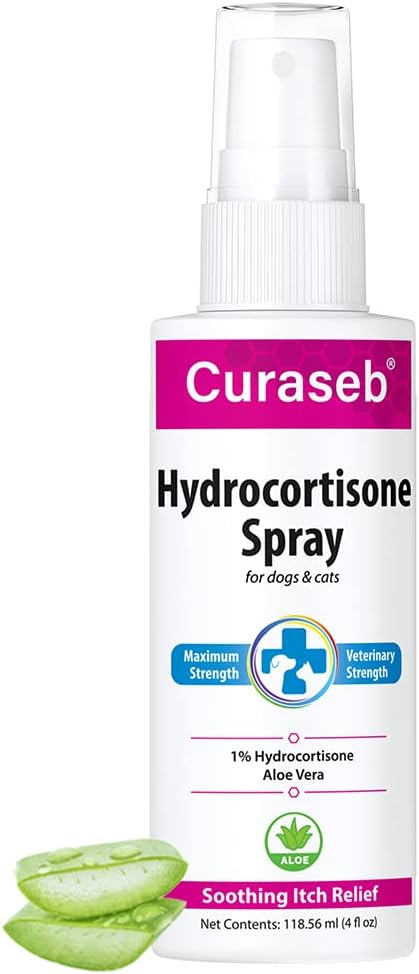iHeartDogs is reader-supported. When you buy via links on our site, we may earn an affiliate commission at no extra cost to you.
In deciphering the signs your dog has allergies, pet parents must become attuned to the subtle and sometimes overt symptoms their canine buddies exhibit. Allergies in dogs, like humans, can range from mild nuisances to severe discomforts, impacting their overall well-being and quality of life. Common indicators include persistent itching, skin irritations, gastrointestinal upsets, and respiratory issues, each pointing toward possible allergic reactions. Understanding these signs is pivotal in recognizing the presence of allergies and initiating timely and effective interventions.
The sources of these dog allergies are diverse, encompassing food allergies, environmental triggers, flea allergy dermatitis, and contact allergies. Each type presents unique challenges and requires specific approaches for management and treatment. Food allergies, often triggered by proteins or grains, require careful dietary modifications, while environmental allergies demand a vigilant approach to minimize exposure to allergens like pollen, dust mites, and mold. Flea allergy dermatitis, a reaction to flea saliva, necessitates stringent flea control and contact allergies require identifying and avoiding irritants. This comprehensive understanding of the various allergy sources is essential for developing an effective treatment plan, ensuring that our canine companions lead comfortable, allergy-free lives.
Recognizing the Signs Your Dog Has Allergies
#1 – Facial Rubbing
Symptom Description: Dogs might rub their face against furniture, carpet, or their paws. Look for redness around the eyes, ears, and snout, which are commonly affected areas.

While it can be adorable, a dog constantly rubbing their face might indicate eye allergies or a reaction to airborne irritants, such as pollen, dust, or mold spores. Dogs may also react this way to certain chemicals found in household cleaning products. Fragranced candles and sprays can cause irritation as well. It can also be a reaction to irritants in shampoos or other grooming products.
#2 – Paw Licking and Chewing
Symptom Description: Persistent licking or chewing of paws, often leading to redness, swelling, or even infections if severe. It can also lead to pain, limping, and secondary yeast or bacterial infection.

Frequently observed in dogs, this behavior can be caused by several factors, including dry skin, wounds, growths, irritants like burrs or ticks, anxiety, and allergic skin disease. Regarding allergies, excessive paw licking could point to a reaction to allergens picked up during walks, such as grass, pollen, or pesticides.
RELATED: 5 Must-Know Tips for Taking Care of Your Dog’s Paws
#3 – Behavioral Changes
Symptom Description: Look for signs like increased irritability, lethargy, or a noticeable decrease in playful activities. A dog in discomfort may also seek isolation or react negatively to being touched.

A sudden shift in mood or energy level can be a subtle sign of discomfort due to allergies. Not feeling well can make anyone, dogs included, not feel like themselves. Both environmental and food allergies can lead to changes in behavior due to discomfort or pain.
#4 – Gastrointestinal Issues
Symptom Description: Symptoms include loss of appetite, vomiting, diarrhea, and sometimes excessive flatulence. These signs can appear shortly after eating the offending food. Symptoms may worsen with continued exposure.

Loss of appetite, vomiting, or diarrhea can signal food intolerances or allergic reactions to certain ingredients in your dog’s diet. Licking air or surfaces could also indicate an upset tummy in dogs. Certain proteins or grains are the typical culprits behind food allergies in dogs. It should be noted, however, that environmental allergens can occasionally cause gastrointestinal upset as well.
#5 – Skin Irritations and Hair Loss
Symptom Description: Look for red, inflamed, or itchy skin, often accompanied by scratching, licking, or biting at the affected areas. Hot spots (areas of particularly intense irritation) may develop, and the skin may become scaly or oily.

Red, irritated, or hot patches of skin are strong indicators of an allergic response, possibly due to contact with allergens, like plants, chemicals, or even certain fabrics. Flea allergy dermatitis is also a common cause, where reactions occur at flea bite sites. Food allergies can also cause skin irritations. All the scratching and biting at the skin can also cause hair loss, leaving your dog with bald or thinning patches in their coat. Some dogs may develop hives, which are raised, itchy bumps on the skin, or experience swelling in the face, ears, lips, eyelids, or earflaps.
RELATED: If Your Dog Has Painful Skin Itchiness, Put This In Their Food!
#6 – Respiratory Issues
Symptom Description: Respiratory issues in dogs due to allergies can manifest in various forms, including sneezing, a runny nose, coughing, and wheezing. Another subtle sign is snoring in dogs that did not previously snore, indicating potential inflammation in the respiratory tract.

Respiratory symptoms are typically caused by airborne allergens such as pollen, dust, mold spores, and scents or chemicals found in household products. Inhaling these allergens can irritate your dog’s respiratory system, leading to the symptoms described. The respiratory signs your dog has allergies can sometimes be mistaken for other respiratory diseases or infections. Therefore, it’s important to consider these symptoms in conjunction with other signs of allergies, like skin irritation or gastrointestinal issues, to determine if allergies are the likely cause.
Respiratory symptoms caused by allergies can significantly impact a dog’s quality of life and, in some cases, may lead to more severe respiratory complications. Contact your veterinarian if your dog is excessively sneezing, coughing, or wheezing.
#7 – Watery Eyes
Symptom Description: Watery eyes or excessive tearing in dogs can be a noticeable symptom of allergies. This condition may present as constant dampness around the eyes, with possible staining of the fur in that area. The discharge is typically clear and not accompanied by a strong odor or pus, which differentiates it from infections.

Watery eyes in dogs can be triggered by various allergens. The reaction is usually the body’s way of trying to flush out these irritants. Common causes include environmental allergens such as pollen, dust, mold, or even certain chemicals found in household cleaning products.
While watery eyes alone can sometimes be a benign condition, when coupled with other symptoms like sneezing, facial rubbing, or skin irritation, it strongly suggests an allergic reaction. Observe if the symptom persists or worsens in certain environments or seasons, which can provide clues about the specific allergen.
If your dog shows signs of discomfort, such as pawing at their eyes or increased redness in the eye area, it’s advisable to consult a veterinarian. Persistent watery eyes can sometimes lead to more serious conditions, such as infections or ulcers, especially if the dog scratches at the irritated area. A veterinarian can provide a proper diagnosis and recommend appropriate treatment, which may include allergy testing or specific eye drops to alleviate the discomfort.
#8 – Ear Infections
Symptom Description: Ear infections in dogs as a result of allergies often manifest as frequent scratching or rubbing of the ears, head shaking, and noticeable discomfort. The inside of the ear may appear red and inflamed, and there might be a noticeable odor or discharge, which can be either waxy or pus-like. Dogs with ear infections may also be sensitive to touch around the ear area, showing signs of pain when their ears are handled.
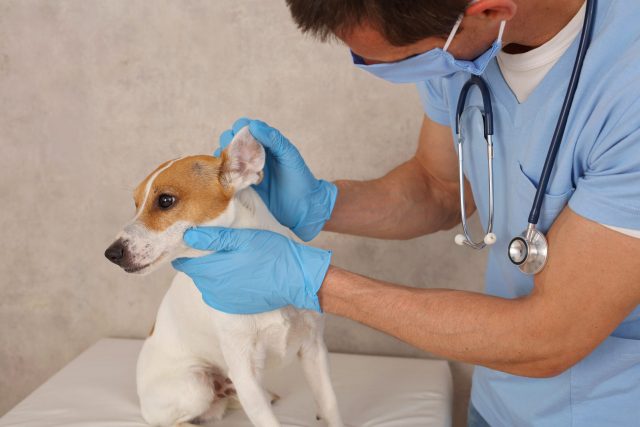
Allergic ear infections are commonly triggered by environmental allergens such as pollen, mold, and dust mites. The allergic reaction leads to inflammation in the ear canal, creating an environment susceptible to bacterial or yeast overgrowth. Food allergies can also contribute to ear infections, though this is less common. In cases of food allergies, the ear infection is often a secondary symptom, with the primary issue being gastrointestinal or skin-related.
Chronic ear infections in dogs can be a sign of an ongoing allergic response and should not be overlooked. Recurring infections might indicate an untreated allergy or an environmental factor that has not been identified or removed. Ear infections can cause significant discomfort and, if left untreated, can lead to more severe complications, including hearing loss. Seek veterinary care if an ear infection is suspected.
Understanding the Sources of Allergies in Dogs
Allergies in dogs can be complex and multifaceted. Here’s a detailed look at the different types of allergies that can affect our canine companions.
#1 – Food Allergies
Food allergies in dogs occur when their immune systems mistakenly identify a specific food ingredient as harmful, leading to an allergic reaction. The most common allergens in dog foods are proteins, predominantly from animal sources like beef, chicken, lamb, or dairy products. However, some dogs can also be allergic to certain grains like wheat or corn.
- Symptoms: Food allergies in dogs can cause various symptoms, including skin irritations (itching, redness), gastrointestinal issues (vomiting, diarrhea), and chronic ear infections.
- Diagnosis and Management: Diagnosing food allergies can be challenging and often involves an elimination diet, where the dog is fed a limited ingredient diet or a novel protein source that they have never had before. If symptoms improve, the suspected allergen is slowly reintroduced to confirm the allergy. Treatment typically involves avoiding the offending ingredient.
Learn more about your dog’s health and how it relates to their diet with 5 Health Problems That Could Be Caused By Your Dog Food.
#2 – Environmental Allergies
Environmental allergies, or atopic dermatitis, are caused by airborne allergens such as pollen, mold, dust mites, and grasses. These allergens can cause seasonal or year-round allergic reactions in dogs.
- Symptoms: Symptoms often include itchy skin, especially around the face, paws, and underbelly, recurrent ear infections, and sometimes respiratory issues like sneezing or coughing.
- Diagnosis and Management: Skin or blood tests can help identify specific environmental allergens. Treatment involves managing symptoms with medications such as antihistamines, corticosteroids, or immunotherapy (allergy shots). Regular bathing and cleaning can also help reduce exposure to these allergens.
#3 – Flea Allergy Dermatitis
Flea allergy dermatitis is an allergic reaction to flea saliva. Even a small number of flea bites can cause a severe reaction in a hypersensitive dog.
- Symptoms: The primary symptom is intense itching, leading to excessive scratching, biting, and potentially secondary skin infections. The base of the tail, back, and legs are commonly affected areas.
- Diagnosis and Management: Flea control is the cornerstone of managing flea allergy dermatitis. This involves regular flea treatment for the dog and its environment. Corticosteroids or antihistamines may be prescribed to control severe itching.
RELATED: The 10 Best Flea & Tick Treatments For Dogs
#4 – Contact Allergies
Contact allergies in dogs are less common signs your dog has allergies and occur when a dog’s skin reacts to certain substances it comes into contact with, such as plastics, fabrics, or even some ingredients in shampoos and household cleaners.
- Symptoms: These allergies usually manifest as skin irritation at the point of contact, which can include redness, itching, and hair loss.
- Diagnosis and Management: Identifying the cause of a contact allergy involves observing when symptoms occur and removing potential allergens from the dog’s environment. Treatment involves avoiding the allergen and possibly using topical medications to relieve skin irritation.
Alleviating Allergies in Dogs
Once you suspect your dog has allergies, a veterinarian should be your first point of contact. They can determine if the reactions are due to food or environmental factors and suggest appropriate tests or elimination diets. In addition to veterinary advice and approval, consider the following steps to alleviate your dog’s allergies.
#1 – Dietary Adjustments
For dogs with food allergies, identifying and eliminating the offending ingredient from their diet is key. This process often involves an elimination diet, which is a trial period where a dog is fed a limited ingredient or novel protein diet (a protein source they have never consumed before). If symptoms improve, the suspected allergen is gradually reintroduced to confirm the allergy. Hypoallergenic dog foods, which contain hydrolyzed proteins or novel protein sources, can also be beneficial. These diets are designed to minimize the risk of triggering an allergic response. Consistent monitoring during dietary changes is essential to assess the effectiveness of this approach.
RELATED: 12 Best Dog Foods For Allergies
#2 – Environmental Controls
In cases of environmental allergies, reducing the dog’s exposure to allergens can significantly alleviate symptoms. Regular bathing can help remove allergens from the dog’s coat and skin, reducing itchiness and irritation. Using hypoallergenic or oatmeal-based shampoos can be beneficial. Additionally, maintaining a clean home environment is crucial. This includes frequent vacuuming, using air purifiers to filter out airborne allergens, and washing the dog’s bedding regularly. For outdoor allergens, wiping the dog’s paws and coat after walks can help remove pollen and other irritants.
#3 – Allergy Shots (Immunotherapy)
For chronic and severe allergy cases, immunotherapy, commonly known as allergy shots, can be an effective long-term treatment. This process involves administering small doses of the allergen to the dog over time, gradually desensitizing the immune system to the allergen. This treatment requires commitment as it can take several months to show results, but it can significantly reduce the severity of allergic reactions in the long term.
#4 – Medication and Supplements
Veterinarians may prescribe medications to manage allergy symptoms. These can include antihistamines to reduce itching and inflammation and corticosteroids for more severe cases. However, these medications can have side effects, especially with long-term use, and should be used under veterinary guidance.
Omega-3 fatty acid supplements, which are known for their anti-inflammatory properties, can support skin health and improve the coat’s condition. These supplements can help manage skin irritation and reduce the need for stronger medications. But which ones are effective and well-received by dogs in the wide market of supplements? Check out our list of standout allergy supplements for help when the signs your dog has allergies get out of control.
7 Allergy Supplements for Dogs
iHeartDogs Allergy & Itch Chews are formulated with high-quality, natural ingredients aimed at soothing irritated skin and providing overall health benefits. They work effectively against a range of allergies, including those triggered by seasonal changes, food, and environmental factors, addressing issues like itching, sneezing, and skin irritation. The inclusion of omega-3 and omega-6 fatty acids bolsters the immune system, supports heart health, and promotes healthy skin and coat. Additional key ingredients such as quercetin, colostrum, Reishi mushrooms, salmon oil, and apple cider vinegar enhance the supplement’s effectiveness. Plus, each purchase of this veterinarian-formulated product also contributes to feeding dogs in need.
PetHonesty’s Dog Allergy Relief Chews Max Strength offers a blend of probiotics that enrich the gut with beneficial bacteria, crucial for optimal digestive health. These soft chews also include colostrum to bolster immunity and fish oil to nurture a healthy skin and coat. The presence of omega-3 fatty acids in each chew further enhances the supplement’s efficacy in combating allergic reactions. This all-natural formula comes highly recommended by veterinarians.
Zesty Paws Advanced Aller-Immune Bites support immune function, help dogs with seasonal allergies, and help maintain histamine levels. The soft chews contain vitamins, protein, fiber, colostrum, omega-3 fatty acids, antioxidants, prebiotics, and probiotics. Together, the ingredients in this functional pet supplement support dogs with seasonal allergies, especially when it comes to immune, skin, and gut health.
Finn Allergy & Itch Supplement for Dogs contain colostrum, wild Alaskan salmon oil, quercetin, bromelain, probiotics, bee propolis, and other key ingredients to help support your dog’s immune response and soothe itchy, dry skin. These chews are formulated to relieve seasonal allergies in dogs and are cold-pressed to preserve the strength of the ingredients. They contain real cheese, bacon, and beef liver, most dogs’ favorite flavors.
The Native Pet Allergy Chews are air-dried treats made with real chicken, so your pup can enjoy a chicken-flavored snack without realizing it’s also an allergy supplement. Vets developed the product, and it can support your dog’s immune system and reduce their seasonal allergies. These chews can reduce red eyes, sneezing, and other discomfort dogs face. And all with only nine ingredients: colostrum, spirulina, dried yeast fermentate, algae oil, bacillus coagulans, bone broth gelatin, chicken, coconut glycerin, and mixed tocopherols. You’ll know exactly what’s going into your dog’s body so you won’t have to worry about triggering any sensitivities.
The Curaseb Hot Spot Treatment for Dogs & Cats, while not an allergy supplement, certainly helps alleviate the signs of your dog’s allergies and the symptoms associated with skin irritations and infections. This product stands out for its effectiveness in treating hot spots, a common issue in both dogs and cats. It offers quick relief from itching and inflammation, reducing the discomfort that allergies can cause. The formula is designed to be gentle yet powerful, targeting the root cause of the problem without causing additional stress. A noticeable improvement can often be seen after just a few applications, making it a reliable choice for pet parents seeking a solution for their furry friends’ skin issues. Just spray and relieve your poor pup’s itchy skin!
For more supplements that help with the signs of allergies in dogs, check out these 10 Best Allergy Supplements For Dogs.
Final Thoughts on Allergy Signs in Dogs
By understanding the sources of and signs your dog has allergies and taking appropriate steps to alleviate them, you can help ensure your furry friend enjoys a comfortable and happy life. Remember, consistent monitoring and working closely with your veterinarian are key to managing canine allergies effectively.




